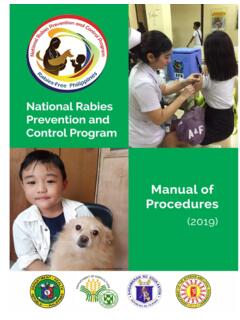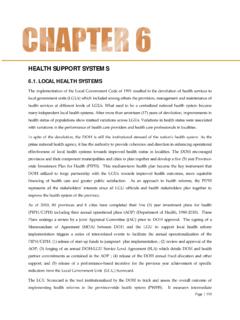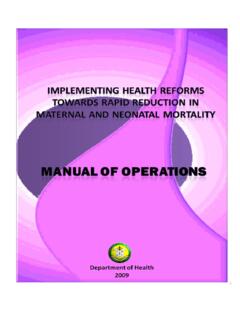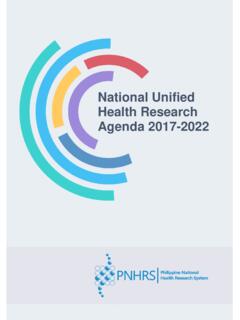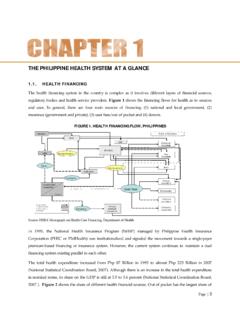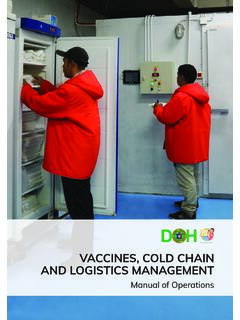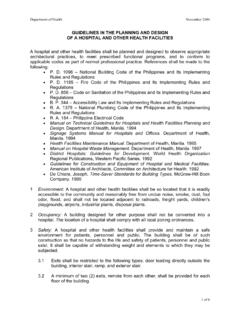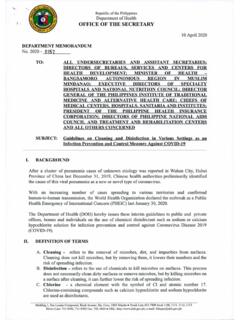Transcription of of OFFICE OFTHE SECRETARY - Secretary of Health
1 Of the Philippines Republic Department of Health OFFICE OF THE SECRETARY . 21 July 2020. DEPARTMENT MEMORANDUM. No. 2020-_ 038|. TO ALL UNDERSECRETARIES AND ASSISTANT SECRETARIES. DIRECTORS OF BUREAUS, SERVICES AND CENTERS FOR. Health DEVELOPMENT; MINISTER OF Health . BANGSAMORO AUTONOMOUS REGION IN MUSLIM. MINDANAO; EXECUTIVE DIRECTORS OF SPECIALTY. HOSPITALS _AND_ NATIONAL NUTRITION COUNCIL;. CHIEFS OF MEDICAL CENTERS, HOSPITALS, SANITARIA. AND INSTITUTES AND ALL OFFICES INVOLVED. SUBJECT : Interim Guidelines on the COVID-19 Disease Severity Classification and Management BACKGROUND. As the number of Coronavirus Disease 2019 (COVID-19) cases continue to rise, appropriate clinical management for the different disease severity of COVID-19 must be undertaken. This is to ensure fast recovery and to reduce mortality.
2 Based on the initial and current Philippine Society for Microbiology and Infectious Diseases (PSMID) and Pediatric Infectious Disease Society of the Philippines (PIDSP). Clinical Practice Guidelines (CPG) for COVID-19, patients are evaluated for their disease severity as either mild, severe or critical for triaging and referral purposes. Adult patients were also initially classified clinically as follows for management purposes: 1. Adults (age<60) with stable or no comorbid diseases and uncomplicated upper respiratory tract infection 2. Adults (age >60) with stable or unstable comorbid diseases and pneumonia 3. Adults with severe pneumonia , severe sepsis or septic shock 4. Adults with Acute Respiratory Distress Syndrome On the other hand, pediatric patients were classified as: 1. Suspect COVID-19 case with Severe/Critical symptoms 2.
3 Suspect COVID-19 case with Non-severe symptoms which may range from Mild to Moderate symptoms 3. Probable COVID-19 case 4. Confirmed COVID-19 case As the situation has evolved and new knowledge and information became available, COVID-19 disease severity classification and corresponding definitions were also updated. The new World Health Organization (WHO) disease severity classification includes mild, moderate, severe and critical diseases. This classification is being used both for referral and management purposes. Building 1, San Lazaro Compound, Rizal Avenue, Sta. Cruz, 1003 Manila e Trunk Line 651-7800 local 1108, 1111, 1112, 1113. Direct Line: 711-9502; 711-9503 Fax: 743-1829 @ URL: ; e-mail: These guidelines are hereby issued to guide the Health facilities and other disease reporting units on the updated definitions of COVID-19 disease severity classification based on WHO Clinical Management of COVID-19 27 May:2020 and the PSMID Clinical Practice Guidelines as of July 20, 2020.
4 I. DISEASE SEVERITY CLASSIFICATION OF PATIENTS WITH PROBABLE OR. CONFIRMED COVID-19. A. Mild Disease 1. Symptomatic patients presenting with fever, cough, fatigue, anorexia, myalgias;. other non-specific symptoms such as sore throat, nasal congestion, headache, diarrhea, nausea and vomiting; loss of smell (anosmia) or loss of taste (ageusia). preceding the onset of respiratory symptoms with NO signs of pneumonia or hypoxia B. Moderate Disease 1. Adolescent or adult with clinical signs of non-severe pneumonia ( fever, cough, dyspnea, respiratory rate (RR) = 21-30 breaths/minute, peripheral capillary oxygen saturation (SpO2) >92% on room air). Child with clinical signs of non-severe pneumonia (cough or difficulty breathing and fast breathing [ < 2 months: > 60; 2-11 months: > 50; 1-5 years: > 40] and/or chest indrawing).
5 C. Severe Disease I. Adolescent or adult with clinical signs of severe pneumonia or severe acute respiratory infection as follows: fever, cough, dyspnea, RR>30 breaths/minute, severe respiratory distress or SpO2 < 92% on room air Child with clinical Signs of pneumonia (cough least one of the following: or difficulty in breathing) plus at a. Central cyanosis or SpO2 < 90%; severe respiratory distress ( fast breathing, grunting, very severe chest indrawing); general danger sign: inability to breastfeed or drink, lethargy or unconsciousness, or convulsions. b. Fast breathing (in breaths/min): < 2 months: > 60; 2-11 months: > 50; 1-5. years: > 40. PD. Critical Disease - Patients manifesting with acute respiratory distress syndrome, sepsis and/or septic shock 1. Acute Respiratory Distress Syndrome (ARDS).
6 A. Patients with onset within 1 week of known clinical insult ( pneumonia ) or new or worsening respiratory symptoms, progressing infiltrates on chest X-ray or chest CT scan, with respiratory failure not fully explained by cardiac failure or fluid overload 2. Sepsis a. Adults with life-threatening organ dysfunction caused by a dysregulated host response to suspected or proven infection. Signs of organ dysfunction include altered mental status, difficult or fast breathing, low oxygen saturation, reduced urine output, fast heart rate, weak pulse, cold extremities or low blood pressure, skin mottling, or laboratory evidence of coagulopathy, thrombocytopenia, acidosis, high lactate or hyperbilirubinemia b. Children with suspected or proven infection and > 2 age-based systemic inflammatory response syndrome criteria (abnormal temperature [> C.)]
7 Or < 36 C); tachycardia for age or bradycardia for age if < 1 year; tachypnea for age or need for mechanical ventilation; abnormal white blood cell count for age or > 10% bands), of which one must be abnormal temperature or white blood cell count. 3. Septic Shock a. Adults with persistent hypotension despite volume resuscitation, requiring vasopressors to maintain MAP > 65 mmHg and serum lactate level >2. mmol/L. b. Children with any hypotension (SBP < Sth centile or > 2 SD below normal for age) or two or three of the following: altered mental status; bradycardia or tachycardia (HR < 90 bpm or > 160 bpm in infants and heart rate < 70. bpm or > 150 bpm in children); prolonged capillary refill (> 2 sec) or weak pulse; fast breathing; mottled or cool skin or petechial or purpuric rash; high lactate; reduced urine output; hyperthermia or hypothermia.
8 II. IMPLEMENTING GUIDELINES. A. All Health facilities and other disease reporting units shall follow the definitions above. The reporting mechanism of the disease severity will be detailed in a separate issuance. After initial assessment, management and stabilization, patients shall be referred to the appropriate COVID-19 care destination: within the Health facility (critical care unit or ward), to a different Health facility, temporary treatment and monitoring facility or home, according to patient medical needs and established COVID-19 care pathways. Patient care pathway for each disease severity classification shall follow the Algorithm For COVID-19 Referral and Triage (See Annex A) as adopted in the PSMID Clinical Practice Guidelines as of July 20, 2020. Patients with mild illness may not require emergency interventions or hospitalization.
9 However, patients with moderate, severe or critical illness should be admitted in a hospital. Isolation is necessary for all suspect, probable or confirmed cases regardless of severity to contain virus transmission. Some patients develop severe pneumonia and require oxygen therapy, and a minority progress to critical disease with complications such as respiratory failure or septic shock. Early identification of severe disease shall be ensured to allow rapid initiation of optimized supportive care treatments and safe, rapid referral to a designated COVID-19 referral hospital (with access to oxygen and respiratory support). Known risk factors for rapid deterioration, severe disease, and/or increased mortality are: older age (> 60 years) and non-communicable diseases such as cardiovascular disease, diabetes mellitus, chronic lung disease, cancer and cerebrovascular disease.
10 Patients with one or more of these risk factors should be monitored closely for deterioration. G. Detailed clinical management for each COVID-19 disease severity classification shall follow the current local clinical practice guidelines by the Philippine Society for Microbiology and Infectious Diseases (See Annex B). H. Health care provider networks faced with limited range of service capabilities and absorptive capacities, may adopt localized service allocation across all public and private Health care providers; provided that, (a) the goal of ensuring that the right patient is given the right service at the right time is achieved; (b) with a plan to continually expand network-wide service capability is in place; and (c) in consideration of equitable access to Health service, and capability of provider to deliver the appropriate service.
